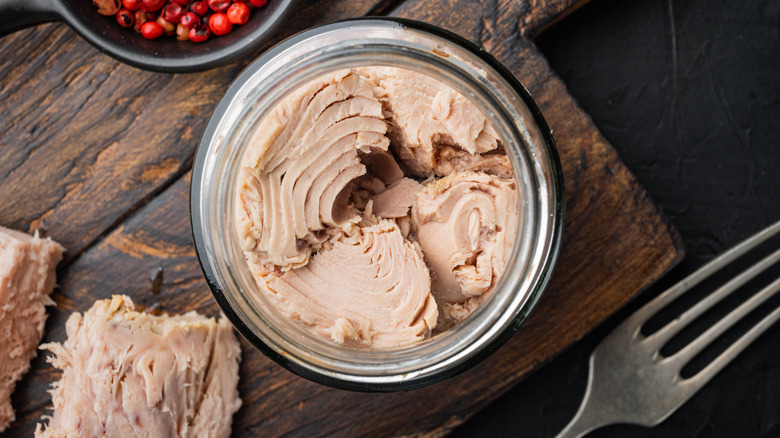Why You May Want To Can Dark And Light Tuna Meat Separately
Of all the ready-to-use ingredients we stock in our pantries — from canned tomatoes to jarred olives to peanut butter — canned tuna just might be one of the most versatile. Well known for the starring role it takes in creamy, hearty tuna salad, the pantry staple also brings brininess, meatiness, and plenty of protein to dishes as varied as pasta, colorful Nicoise salad, and nostalgia-provoking tuna casserole (via Healthline).
As affordable as it is delicious, canned tuna is widely beloved, with about 88% of Americans dining on it regularly — the majority at least twice a month, according to the National Fisheries Institute. If you, too, regularly purchase canned tuna, you might be interested to know that it's actually fairly easy to can at home — but you might want to can the dark part of tuna's flesh separately from the white part, per the National Center for Home Food Preservation. Here's why.
Dark meat tuna has a flavor too intense for some
If you've chowed down on raw tuna in the form of sushi or sashimi, then you know it can range in color from rosy pink to intensely crimson (via Sweetish Hill). After it's cooked, however, tuna turns very pale and almost white — a contrast anyone can see when you sear a tuna steak until rare, with the outside turning pale while the interior remains red. As you know if you've enjoyed canned tuna, it also looks pale in color thanks to precooking and then canning.
When canning tuna at home, however, you'll notice that on any fresh tuna steak, there will be a section of flesh that's much darker. Rich in myoglobin, a blood pigment, this part of the tuna is quite edible and highly nutritious, according to Sweetish Hill, but it has a strong flavor that some diners might not like. Therefore, when you're canning tuna at home, suggests the National Center for Home Food Preservation, you might want to cut out those darker sections of tuna, consolidate them, and can them separately from the lighter meat — either for feeding to pets, or to true tuna superfans.
After precooking raw tuna and removing bones, fins, and blood vessels, you'll pack it into jars, add water or olive oil to cover it and process it in a canner for a little less than two hours. And voilà! Canned tuna for people and for pets, depending on your palate.

